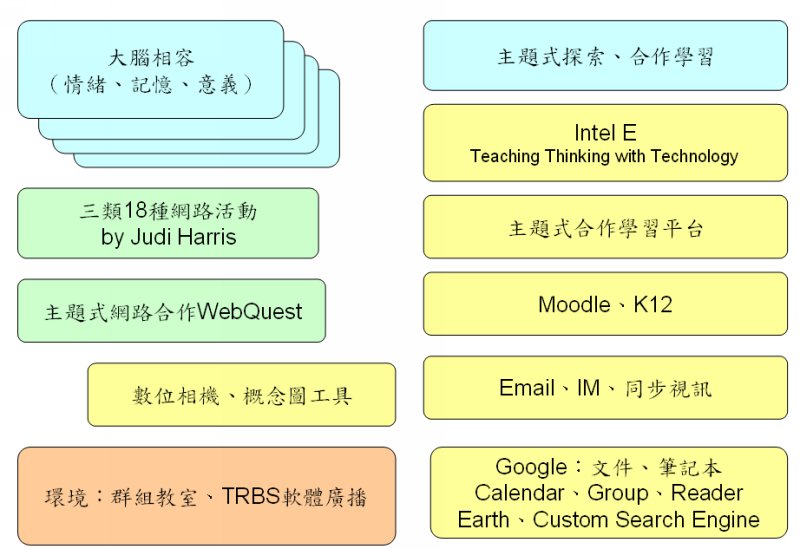 我的教學與大腦相容嗎?
我的教學與大腦相容嗎?
作者:塾長 日期:2011-05-24 19:13
這是上回借的『How the Brain Learns 』書中有張提示清單:How Brain Compatible Is My Teaching/School/District?我把題目與簡單翻譯整理起來,可以提醒自己一番~
1.I/We adapt the curriculum to recognize the windows of opportunity students have during their cognitive growth.
課程能配合提供學生認知成長的機會之窗
2.I/We are trained to provoke strong, positive emotions in students during the learning process.
學習過程中能促進學生積極正向的情緒
3.I/We are trained to help students adjust their self-concept to be more successful in different learning situations.
幫學生調提昇自我概念,在不同學習情境中愈加成功
4.I/We provide an enriched and varied learning environment.
提供豐富多樣的學習環境
5.I/We search constantly for opportunities to integrate curriculum concepts between and among subject areas.
持續尋找整合多領域課程概念的機會
6.Students have frequent opportunities during class to talk about what they are learning, while they are learning.
在學習的課堂中,學生持續有『討論他們正在學什麼』的機會
7.I/We do not use lecture as the main mode of instruction.
不以講述為主要的教學形式
8.One of the main criteria I/we use to decide on classroom activities and curriculum is relevancy to students.
我決定採用於教室活動與課程的主要標準是『是否與學生有關連』
9.I/We understand the power of chunking and use it in the design of curriculum and in daily instruction.
我瞭解組塊(chunking)的力量,並利用於每日課堂的設計中
10.I/We understand the primacy-recency effect and use it regularly in the classroom to enhance retention of learning.
我瞭解近因效應(primacy-recency effect),並經常應用於教室中以促進學習保留
您也可以參考『大腦ABC 』與『大腦相容12原則 』,相信會更有體驗與實踐的發想喔!我還找到一本『The Brain-Compatible Classroom . Using What We Know About Learning to Improve Teaching』,繼續努力k!
 三本書看大腦相容、無所不在學習機會的現在、未來
三本書看大腦相容、無所不在學習機會的現在、未來
作者:塾長 日期:2010-05-25 20:29
一放學就到師大圖書館,只為這本「Brain-based learning : the new paradigm of teaching 」第二版。是因為看到這篇『A Fresh Look at Brain-Based Education 』,才知道該書有第二版(2008)了。
意外地又找到『Handbook of research on practices and outcomes in e-learning : issues and trends 』,首章『Computer-Mediated Learning: What Have We Experienced and Where Do We Go Next?』,是台灣學者寫的喔!
還有這本『Looking toward the future of technology-enhanced education : ubiquitous learning and the digital native 』,我最喜歡這一章『How to Improve Media Literacy and Media Skills of Secondary School Teachers in Order to Prepare Them for the Next Generation of Learners A New Type of In-Service Training for Teachers』,呵呵,正好是本書章名最長的呢!說得也很清楚提醒我們:以新的培訓方式讓中學教師具備媒體素養與技能以教導下一代學習者。
兩本都是2010年出版的耶,不只書大又厚,而且價格也可觀啊~分別是新台幣14000與5200....喔,愈認真看就有『賺很多』的感覺呢!哈哈~
從大腦相容的教學經營,到學校的學習型組織轉變,以及提供無所不在的學習機會,都有賴我們一齊努力以開創未來喔!
後記:寫到這裡才用平常心來看博士班初試結果....喔喔!有機會把借書證從校友版再換成學生版呢!加油加油!
 大腦相容、合作學習與群組教室
大腦相容、合作學習與群組教室
作者:塾長 日期:2007-11-25 21:44
 大腦相容12原則
大腦相容12原則
作者:塾長 日期:2007-08-28 06:14
這是從
也就是這本:創設連結:教學與人腦 (簡體版中譯)摘錄出來的,藍色分類為Fogarty在『課程統整的十種方法』書中所提:
建立學習環境
1.學習因挑戰而提昇其效果。
2.情緒是統整學習的關鍵因素。
3.學習同時牽涉聚焦與廣泛的知覺訊息。
運用外顯及內蘊的記憶系統
4.大腦同時處理部分與整體的訊息。
5.大腦內有一套空間記憶系統,及一套死背的記憶系統。
輸入訊息的處理
6.大腦是一個平行處理器。
7.學習是一全面性的身體活動。
8.每一個大腦都是獨一無二的。
9.當事件儲存於自然的空間記憶系統時,理解與記憶的情況最佳。
意義的形成
10.意義形成的作用乃是持續發展的。
11.意義形成的作用經由統整的學習而產生。
12.學習包含意識及無意識過程。
Fogarty從統整課程、多元智慧與PBL切入作為課程與教學設計的參照(參考前文) 。
我們可以先體驗自己的腦運作是否如此、在教學中與一整班學生互動時,可以對大家的『大腦現況』了解與影響多少?
給太多片段知識與規範,不如給個讓個人自我連結與意義建構的時機和方法
再由此來看:重要的是腦與腦之間的對話,端看教室現場中的人、設備與『時間、活動』的流程鋪陳,某種層面來想:用我們對電腦、網路溝通的概念,對於大腦運作的教學策略,也能激發新想法呢!我想:e化的初衷本應在此,別偏廢而捨本逐末才好。
- 1


